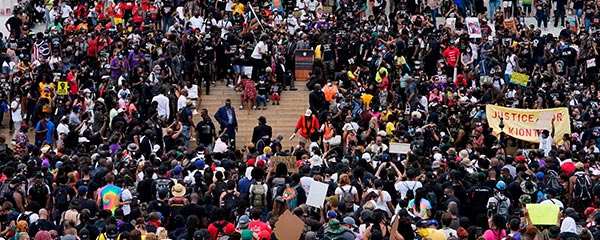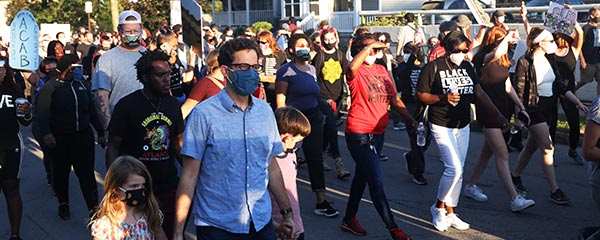Story Highlights
- Ten percent of Americans continue to name race as nation's top problem
- While down from 18% last June, it exceeds the 4% prior to Floyd's death
- Concern remains elevated among White, Hispanic and Black Americans
WASHINGTON, D.C. -- More than half a year after George Floyd's death during a police encounter ignited nationwide protests and discussion around racial justice, Americans' belief that race relations is the top problem facing the country remains higher than it was before those events.
The percentage of U.S. adults citing race-related matters -- including race relations, racial justice and racial unrest -- rose from 4% last May, before video footage of the May 25 incident went viral, to 19% in June. It stayed high, at 16%, in July but subsequently settled into the 10% range, where it remains in Gallup's latest measure at the start of 2021.
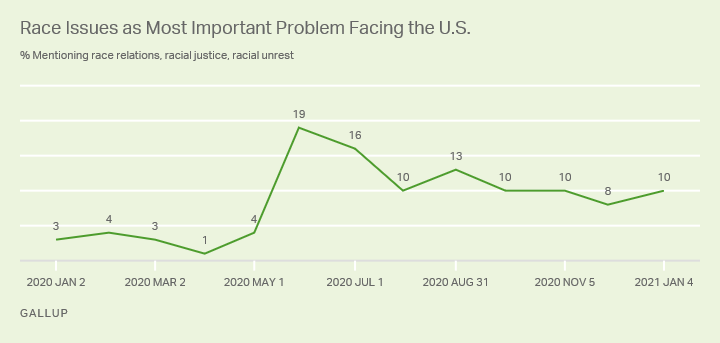
Line graph. Monthly trend from January 2020 to January 2021 in Americans' mentions of race as the most important problem facing the United States. After rising from 4% in May 2020 to 19% in June, it fell to 16% in July and 10% in August. Mentions have since ranged from 8% to 13%, including 10% in January 2021.
While race relations has ranked among the top four most frequently mentioned problems each month since last spring, it has consistently trailed the coronavirus and problems with government at the top of the list. In January, it roughly tied with the need to "unify the country."
Racial Gap in Views Narrows After Widening Last Year
The trendline in perceptions that race is the country's top challenge differs slightly among racial and ethnic groups. This is based on aggregated data in order to increase the sample size and statistical reliability of the estimates.
Among Black Americans, mentions of race rose 24 percentage points after Floyd's death, from an average 8% last April and May to 34% in June and July. Citations of race then fell 10 points to an average 24% from August to November and to 13% by December and January.
By contrast, mentions of race rose less sharply in the months after Floyd's death among Hispanic and Non-Hispanic White Americans. Over the summer, these mentions remained high among Hispanic Americans while they dropped by half among White Americans.
Still, seven months after the incident, race relations remained a more prominent concern among all three groups in January than it was last spring.

Line graph. Trend from April-May 2020 to Dec 2020-Jan 2021 in mentions of race as the most important problem facing the United States among major racial/ethnic groups. Mentions of race spiked sharply among Black, Hispanic and White Americans in June-July 2020 following George Floyd's death. It has since declined but remains higher among all groups in the latest reading than in the reading just before Floyd's death.
Focus on Race Less Prolonged After Other Shooting Incidents
The increase and subsequent decline in Americans naming racial issues as the country's top problem since Floyd's death is a familiar pattern in the public's reaction to prominent racial incidents, including major protests against Black men dying at the hands of police.
However, the cycle was shorter for other recent instances, even when concern spiked into the teens, most notably in 2014, 2016 and 2017. Given the quick nature of these increases, it is not possible to analyze the trends by race as that requires combining multiple months of data to examine each time period.
2016
Americans' mentions of race issues as the nation's top problem increased nearly as much in July 2016 after a series of shootings as they did after Floyd's death in 2020. The percentage of Americans citing race issues as the nation's top problem rose from 5% in June 2016 to 18% in July.
This occurred after nationwide protests erupted over police shootings of two Black men (Alton Sterling and Philando Castile) in different incidents. It also followed the revenge killing of five White police officers by a gunman at one of these protests in Dallas.
Yet the following month, citations of race had dropped by more than half to 7% -- nearly as low as the June reading.
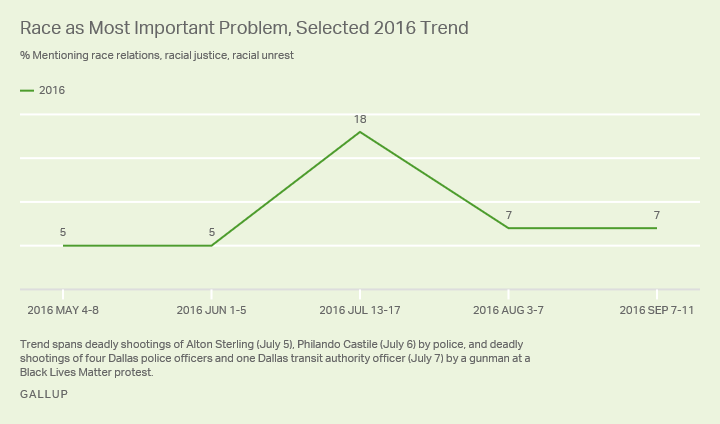
Line graph. Monthly trend from May 2016 to September 2016 in mentions of race as the most important problem facing the United States. Mentions increased from 5% in June 2016 to 18% in July 2016 after national protests erupted over two police shootings of young black men. By August, it had fallen back to 7%.
2014
A similar spike occurred in December 2014 after protests erupted in New York City over a grand jury decision not to indict the police officer involved in the death of a Staten Island man, Eric Garner, who died in a police chokehold. That month, 13% named race relations as the most important problem facing the U.S., compared with 1% in November and 3% in October.
Mentions of race as the most important problem returned to single digits quickly after the Garner protests, dipping to 5% in January 2015 and 3% in February 2015.

Line graph. Monthly trend from October 2014 to February 2015 in mentions of race as the most important problem facing the United States. Mentions spiked from 1% in November 2014 to 13% in December 2014 after national protests erupted following the acquittal of police officers in the death of Eric Garner in New York.
2017
Race relations garnered considerable attention toward the end of 2017 after a "Unite the Right" rally in Charlottesville, Virginia in August descended into violent clashes between White nationalists and counter-protestors. President Donald Trump was widely criticized in the weeks that followed for not condemning the White nationalists and neo-Nazis involved strongly enough and for saying there were "good people on both sides."
Mentions of race relations as the nation's top problem increased from 7% in August 2017 to 12% in September and 14% in October, but by January 2018, four months after the initial increase, they returned to 7%.
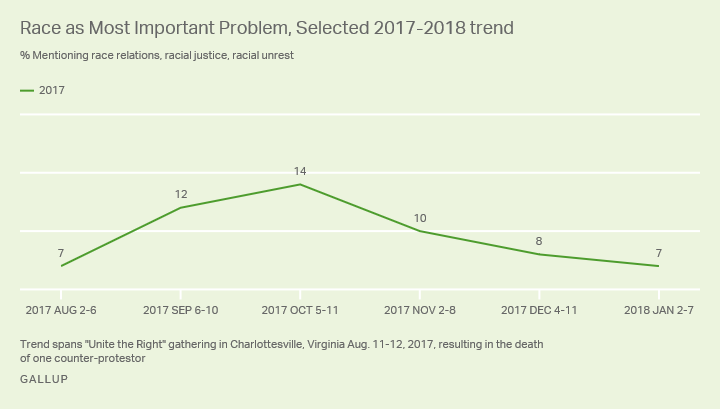
Line graph. Monthly trend from August 2017 to January 2018 in mentions of race as the most important problem facing the United States. Mentions rose from 7% in August 2017 to 12% in September 2017 and 14% in October after a Unite the Right gathering in Charlottesville led to violent clashes between White-nationalists and counter-protestors. Mentions gradually subsided to 7% by January 2018.
1992
The 1992 Los Angeles riots in late March of that year resulted in a significant spike in race being mentioned as the nation's lead problem, but it receded fairly quickly. The multi-day riots were sparked by the acquittal of White police officers who were seen on tape beating Rodney King, a young Black man, after a high-speed chase.
After barely registering as the nation's top problem in March 1992, racial matters were cited by 15% of U.S. adults in early May, shortly after the Los Angeles riots. By the time of Gallup's next measure, about three months later, in late August/early September, the figure was back below one percent.
Bottom Line
George Floyd's death and the nationwide protests that followed led to a relatively large percentage of Americans naming race-related issues as the top problem facing the country last year, even as the pandemic competed for public attention. The 10% naming it in January was well below the peak of 19% last June (by one point the highest recorded since the Civil Rights era), but it remained elevated from the 4% recorded before Floyd's death last May. This seven-month stretch of heightened mentions of race well exceeds the zero to three months of elevated concern following other periods of sharply higher concern since 1992.
The surge in public concern about race in the first two months after Floyd's death was much stronger among Black Americans than White or Hispanic Americans. But since decreasing rather sharply in the months since, Black Americans are now about as likely as Hispanic Americans to see race as the chief problem facing the country. The rate is lower among White Americans, but all three groups are now more attuned to race as a national challenge than they were before witnessing Floyd's death and the reaction it spawned. Whether that continues under the new administration led by President Joe Biden remains to be seen.
Learn more about how the Gallup Poll Social Series works.

